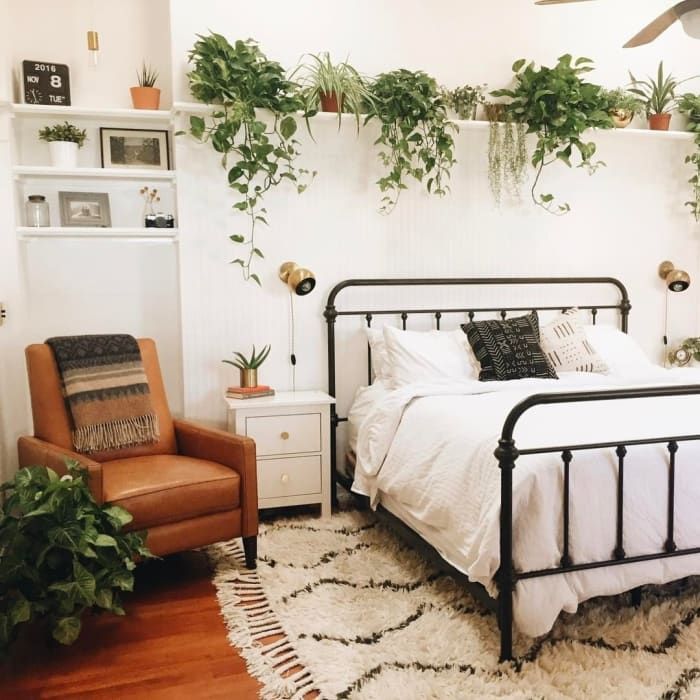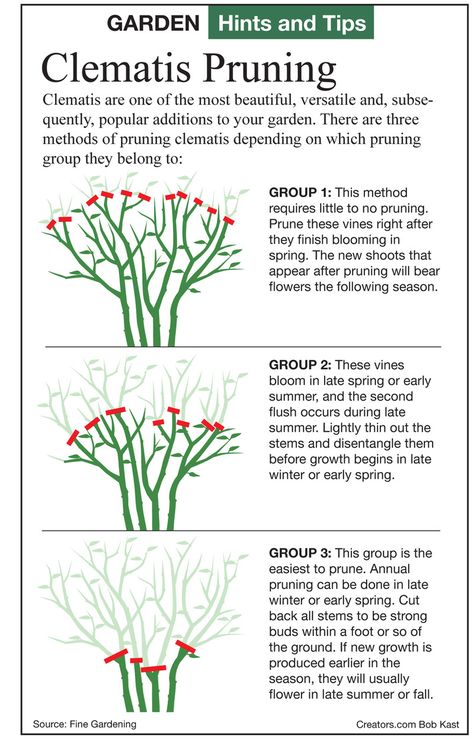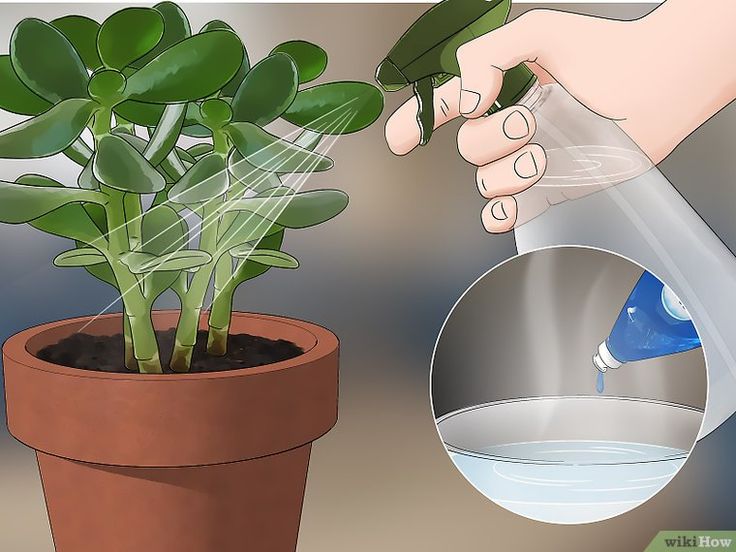Rose garden design
Rose Garden Ideas - How to Design with Roses
Create a beautiful rose garden for your front or back yard, small or large garden, and learn what to plant with roses By Janet Loughrey, Garden Writer & Photographer
At Last® rose. Photo by: Proven Winners
Other Popular Rose Topics:
- Rose Bush Care: A Beginner's Guide
- How to Prune Roses - 8 Steps
- How to Fertilize Roses
- The Best Types of Roses to Grow
- Easy Shrub Roses to Grow
- See all
As one of the world’s most beloved garden plants, roses deserve a prominent spot in the landscape. While these long-lived shrubs have a reputation of being somewhat fussy, newer cultivars bred for disease-resistance and vigor have made growing roses easy for even novice gardeners.
A rose garden can be as simple as a single rose specimen interspersed with a few other plants. It can be as elaborate as a formal landscape embellished with hardscaping, arbors, seating, and statuary. Even smaller spaces can accommodate roses in containers, raised beds, or narrow side yards. Here are the basics of rose garden design, along with some ideas to get you started.
On this page: Planning | Different Spaces | Landscaping Tips | What to Plant With Roses | Design Ideas | More Rose Gardens | Related Reading
On this page:
- PLANNING A ROSE GARDEN
- ROSE GARDENS IN DIFFERENT SPACES
- ROSE GARDEN LANDSCAPING TIPS
- WHAT TO PLANT WITH ROSES
- ROSE GARDEN DESIGN IDEAS
- MORE ROSE GARDENS
- RELATED READING
PLANNING A ROSE GARDEN
Choose your site:
Make sure the site gets at least 6-8 hours of sun a day and has good air circulation to help prevent disease.
Make a plan:
- Gather ideas from books and online sources for inspiration.
- Draw up a rough sketch as you’re brainstorming to help visualize what the finished garden will look like.
- Include pathways for easy access.

- Beds should be small enough to allow for pruning and other maintenance chores.
- Consider structures such as pergolas, arbors or trellises, as well as seating and decorative accents.
Choose a style:
Decide what kind of rose garden you want. Do you want a clean formal look with structured hardscape, or a more natural appearance with other plants mixed in? Pick a style that will harmonize with your home’s exterior.
Pick a color scheme:
Select colors that you enjoy and that will also help unify the home with the landscape.
Prepare the soil:
Roses like rich, well-draining soil with a slightly acidic pH between 6.0-7.0. Amend the soil with compost or other organic matter. For containers, use a high quality all-purpose potting soil and make sure pots have adequate drainage holes.
Plant selection:
Choose roses that are easy-care and hardy in your region. Select varieties for traits including size, shape, flower color, and form, fragrance and repeat or continual bloom.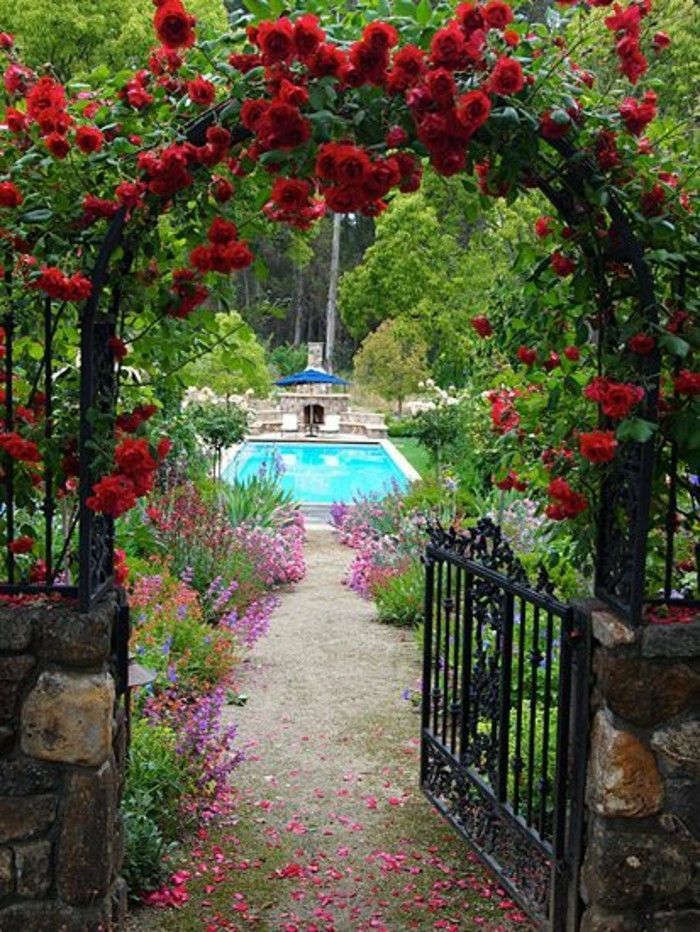 Many newer varieties such as Oso Easy Roses are bred for disease-resistance, vigor, and long bloom time. Some older types, particularly hybrid teas, can be higher maintenance and more disease-prone.
Many newer varieties such as Oso Easy Roses are bred for disease-resistance, vigor, and long bloom time. Some older types, particularly hybrid teas, can be higher maintenance and more disease-prone.
CREATE A ROSE GARDEN IN DIFFERENT TYPES OF SPACES
Plant fragrant rose varieties near a deck or patio to enjoy their fragrance up close. Gardener: Diana Gough. Designer: Phil Thornburg. Photo by: Janet Loughrey.
Large rose garden:
- Create a design with formal rooms or mixed borders that are grand in scale so it doesn’t get lost in the surrounding landscape.
- Keep scale in mind when adding hardscape, seating and structures such as arbors and pergolas, which are typically included in rose gardens.
- Choose larger rose varieties that will show up better in the landscape.
- Plant in drifts of 3 to 5 specimens of the same variety for greater visual impact.
- Plant larger groupings with the same flower color for a more unified look.
Small rose garden:
- Choose smaller rose varieties that will stay in scale with a more intimate space.
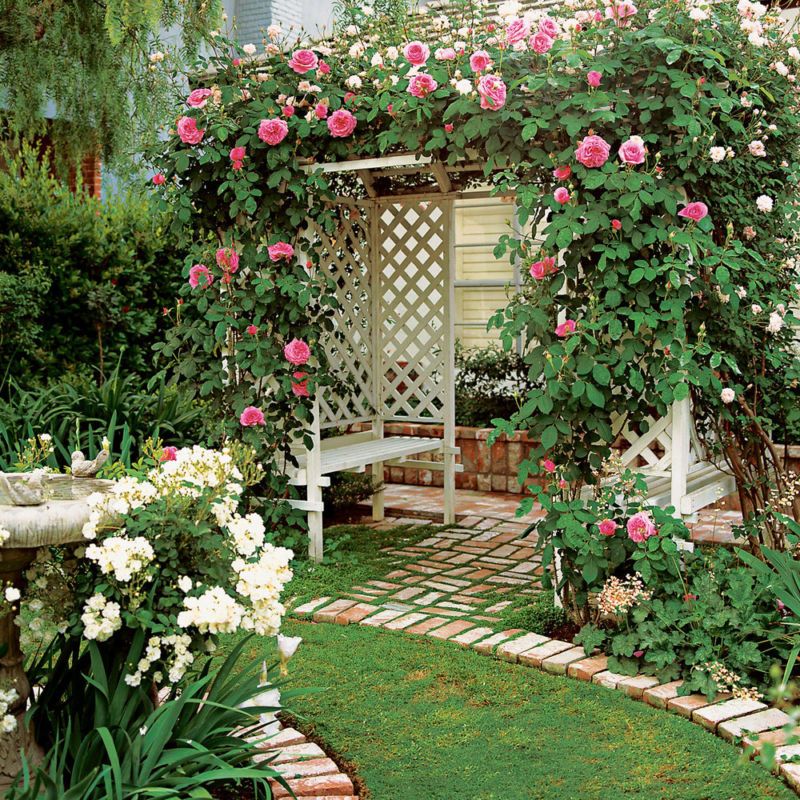
- Maximize the use of space by including vertical elements such as climbing roses and trellises.
- Select a few key rose specimens rather than trying to crowd in a lot of different varieties.
- Limit the color scheme to one or two hues so the design doesn’t look too busy.
- Choose roses with lighter colored flowers in hues of white or yellow to make the space look larger and brighter.
Front yard rose garden:
- Leave plenty of room around rose plants so they don’t crowd sidewalks or other trafficked areas.
- Don’t allow plants to obstruct entrances or doors so visitors don’t get scratched by thorns.
- For foundation plantings, allow enough distance between shrubs and the home’s facade to provide adequate air circulation.
Backyard rose garden:
- Include seating areas in different parts of the yard, which will encourage you to spend more time enjoying your rose garden.
- Site the rose garden where you can enjoy it from inside the home.
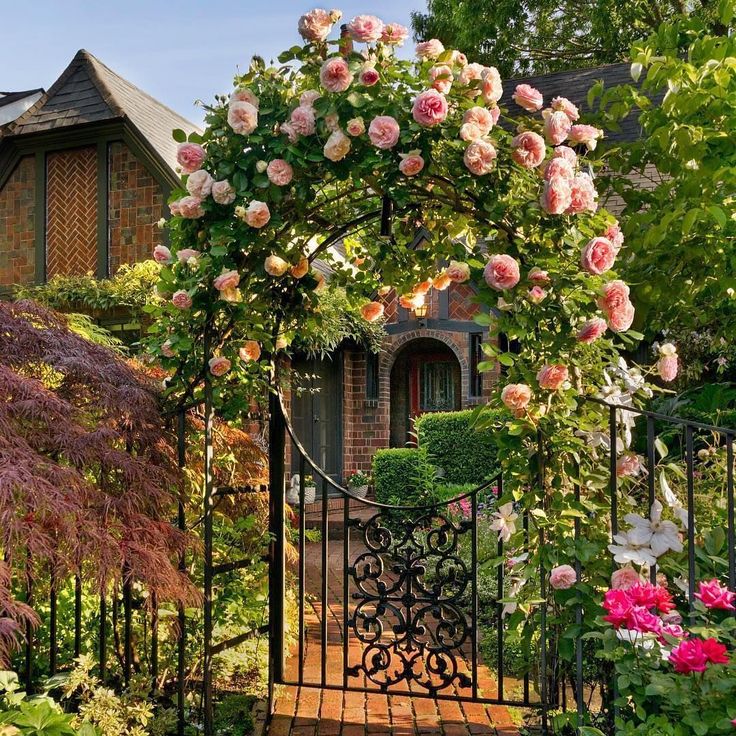
- Plant fragrant rose varieties near a deck or patio where you can enjoy the sweet perfume.
- Place a bench, water feature, or statuary at the far end of the rose garden to draw the eye through the landscape and encourage visitors to wander and linger.
ROSE GARDEN LANDSCAPING TIPS
Create a grand entrance to your home with a rose-covered arbor. Gardener: Mary DeNoyer. Photo by: Janet Loughrey.
Grow vertically:
Include climbing roses to maximize your space. Train other vining plants such as clematis to grow up through shrub or climbing roses to create exciting flower combinations.
Grow horizontally:
Train climbers along a fence to define garden rooms or to soften an unsightly chain link fence.
Plant in containers:
Many roses can be successfully grown in containers, a good solution for small spaces, apartment balconies, patios, and decks. Containers should be at least 15 to 20 inches in diameter and 18 to 24 inches deep.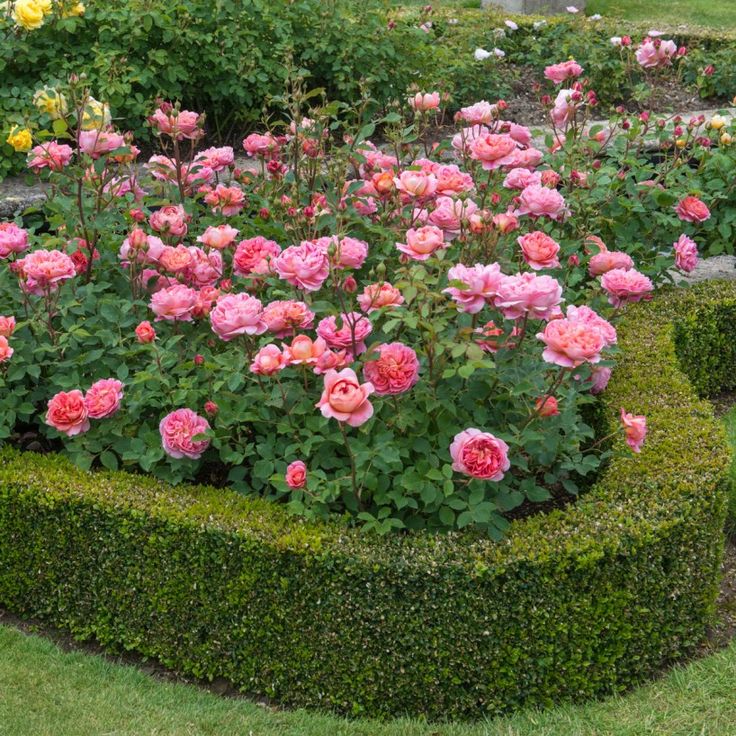 Half whiskey barrels work well. Miniature roses can be grown in smaller pots or hanging baskets. (See more on growing roses in pots.)
Half whiskey barrels work well. Miniature roses can be grown in smaller pots or hanging baskets. (See more on growing roses in pots.)
Cover a slope:
Mass groundcover varieties such as Flower Carpet® or Drift® roses along a slope for low-maintenance erosion control.
Plant in drifts:
For greater impact, plant in groups of 3-5 specimens of the same variety.
Plant a hedge:
Plant a row of taller shrub roses to create privacy from the street. A row of shorter groundcover roses can be planted along a foundation, in a curbside strip, or used to define garden areas.
Make an entrance:
Create a grand entrance to your home with an inviting entryway complete with a rose arbor and adjacent plantings to soften the landscape.
Create a transition:
Use a rose-covered arbor in a side yard to define the transition between front and back yards.
Use as a background planting:
Place climbers along a tall wooden fence to soften the backdrop and break up the expanse of wood.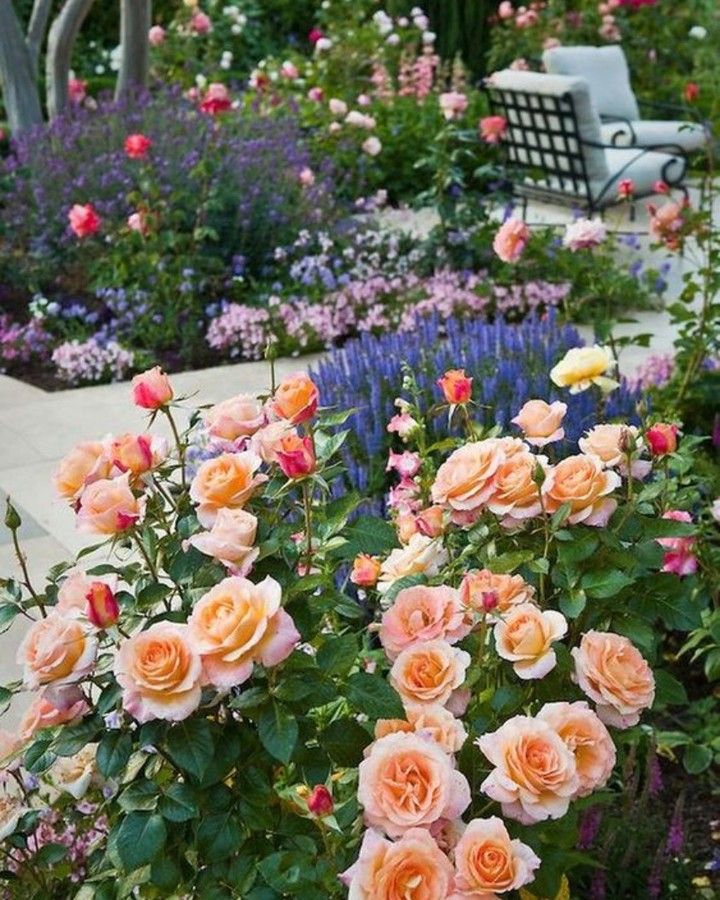
Foundation planting:
Combine landscape roses with other shrubs that bloom at different times along the front of your home for a season-long display of color.
Mixed border:
Use low-growing ground cover roses near the front of a mixed border or taller semi-climbers in back to establish height and layers.
WHAT TO PLANT WITH ROSES
A curbside planting of roses underplanted with perennial geraniums offers screening and privacy. Garden and photo by: Janet Loughrey.
A rose garden can be greatly enhanced by incorporating other plants as part of the overall design. Roses go well with a wide variety of trees, shrubs, perennials and annuals. Choose plants that have the same cultural requirements of full sun, ample water and rich soil.
Also, consider how much maintenance your roses will need:
- Hybrid teas, grandifloras, floribundas, climbers, and miniatures all require regular maintenance and pruning, as well as winter protection in cold climates.
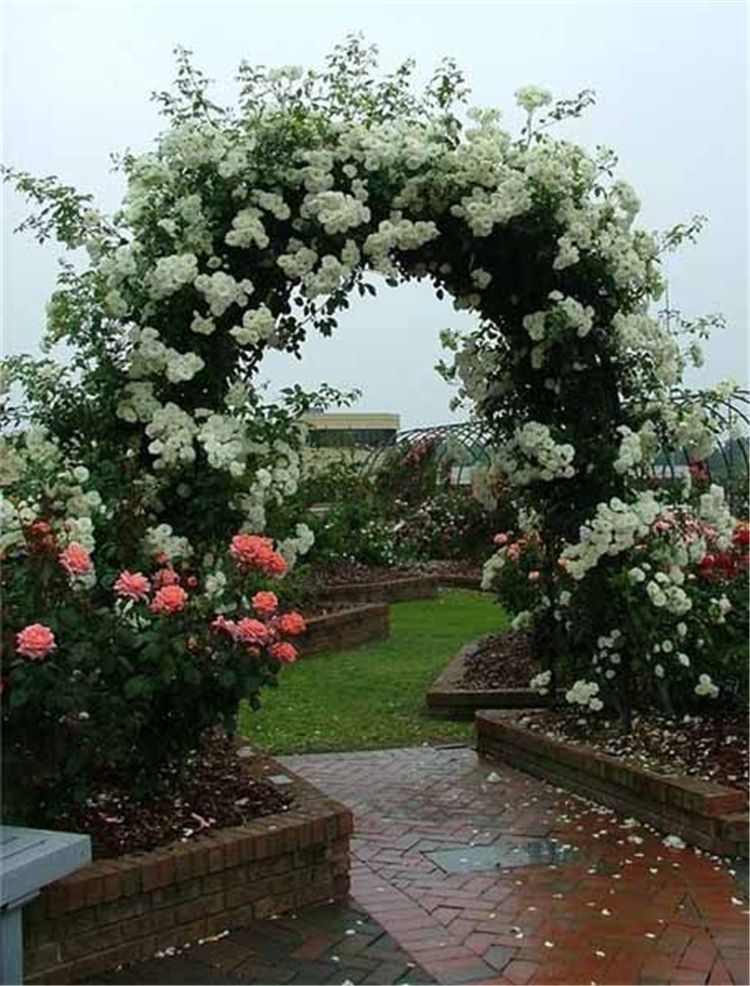 Companion plants should be confined to in front of or behind roses, not in between them, to allow easy access.
Companion plants should be confined to in front of or behind roses, not in between them, to allow easy access. - Species, shrub, old garden, and landscape roses require only minimal maintenance: cleaning up in winter and deadheading as needed when in bloom. These types of roses can be surrounded with perennials, annuals, bulbs, and shrubs.
Flowering companions:
Intersperse plants that flower at different times to extend the bloom season. These can include perennials or annuals such as petunia, verbena, or calibrachoa.
Complement and contrast:
Pair roses with other plants in complementary hues to create drama and contrast. A gold-colored rose such as Oso Easy Lemon Zest® would pair well with Rapido Blue Carpathian bellflower or ‘Violet Profusion’ salvia.
Trees:
Add different heights to a mixed border or formal rose garden with trees. These can include snowbell (Styrax japonicus), fringe tree (Chionanthus virginicus), dogwood (Cornus) and crabapple (Malus).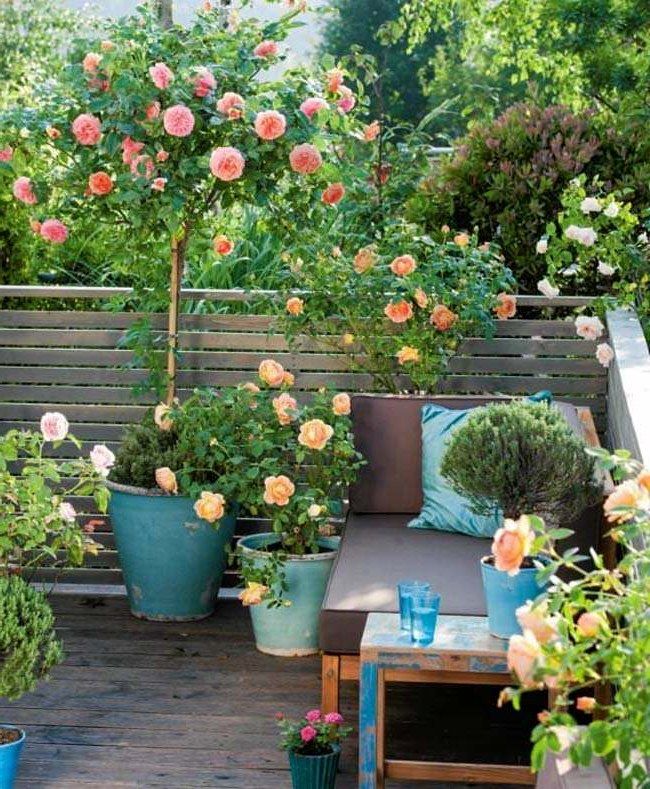
Shrubs:
Enhance the landscape by providing contrasting color, texture, and structure with shrubs. These can include boxwood, spirea, bluebeard, and daphne.
Groundcovers:
Use groundcovers as a living mulch and weed-suppressing carpet. Good rose companions include perennial geraniums, dead nettle, bugleweed, and lady’s mantle.
Perennials:
Provide contrast with perennials of different size, structure, and color. Good rose companions include alliums, lavender, catmint, salvia, phlox, and speedwell.
Vines:
Climbers can be trained up or alongside rose plants for an extra layer of color. These may include clematis, climbing bleeding heart (Dicentra scandens), morning glory and jasmine.
ROSE GARDEN IDEAS
Plant fragrant rose varieties near a deck or patio to enjoy their fragrance up close. Gardener: Diana Gough. Designer: Phil Thornburg. Photo by: Janet Loughrey.
Combine roses with other plants of different heights for a layered tapestry.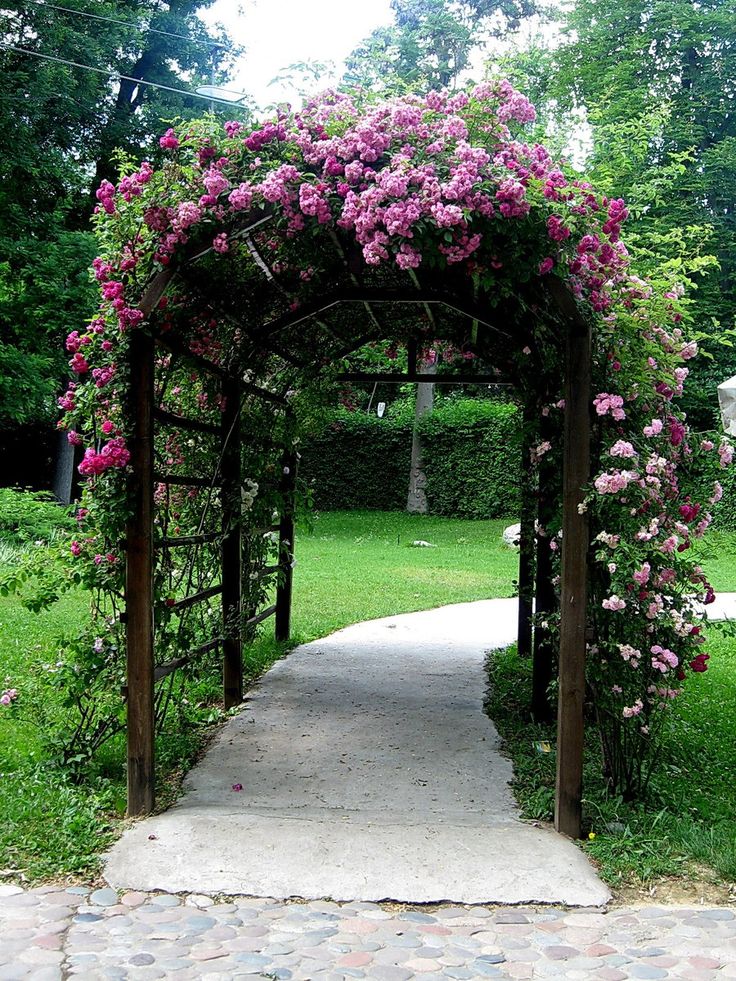 Gardener: Jeff Clark. Photo: Janet Loughrey.
Gardener: Jeff Clark. Photo: Janet Loughrey.
A formal rose garden is characterized by distinct lines, clipped hedging and structures such as pergolas and arbors. Gardener and designer: Nancy Cutler. Photo: Janet Loughrey.
A rose-covered gate marks the transition between the front and back yards. Gardener: Mary DeNoyer. Photo: Janet Loughrey.
Train roses vertically to add varying layers to the landscape. Gardeners: Darin Simmons and Matthew Greydanus, Laurel Hedge. Photo: Janet Loughrey.
Train climbing roses along a fence to create an attractive screen for privacy. Gardeners: Danny Hills and Wayne Hughes, Lonesomeville Gardens. Photo: Janet Loughrey.
Roses combine well with many perennials, shrubs, trees, and annuals. Photo: Matthewshutter / Shutterstock.
MORE ROSE GARDENS
My Garden: An Affinity for Roses
In this front garden, perennials such as catmint, delphinium, and hollyhocks mingle with roses.
From Parking Lot to Rose Garden
See this backyard that was transformed into a spectacular rose garden featuring David Austin roses.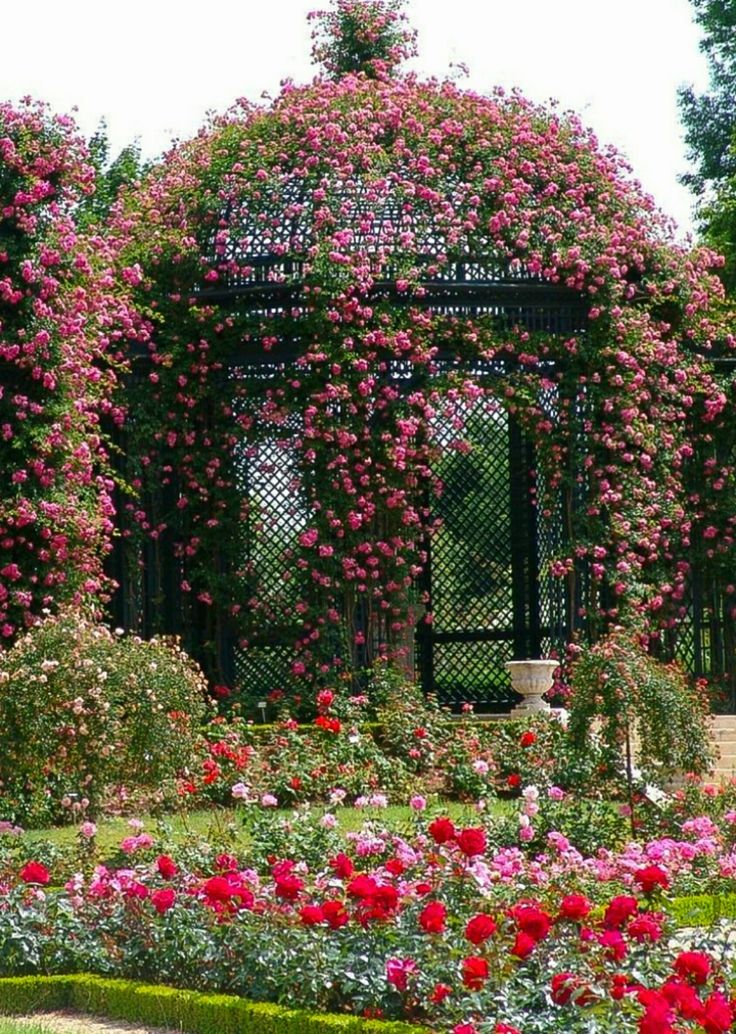
Portland's Rose Test Garden
Another public rose garden, features over 10,000 rose plants from 550 species.
RELATED READING
Rose Care: A Beginner's Guide
Cottage Garden Design
How to Grow Climbing Roses
How to Treat Black Spot on Roses
How to Get Rid of Aphids
How to Get Rid of Powdery Mildew
14 rose gardens to inspire |
(Image credit: David Austin Roses)
Rose gardens have long been symbols of romance and elegance. Loved for large blooms and divine fragrance, the rose is a stalwart of the English garden and there are few plants that can rival its versatility. Available as climbers, ramblers, bushes, shrubs and ground cover roses, in a variety of colors, fragrances and repeat flowering or single blooms, there are a variety of rose garden ideas for almost every position.
Picture a rose garden and it may well conjure images of formal rose gardens designed to pay homage to the classic elegance of roses. Often these gardens consist of symmetrical, geometric borders edged with trimmed box-hedges and infilled with neatly trimmed rose bushes, often arranged by color. However, you don’t need to plant roses in a formal rose garden to appreciate the beauty of roses, there are numerous ways to enjoy them in your garden from climbing over a pergola to in pots on the patio.
We’ve rounded up an array of rose garden ideas to introduce them into your outdoor space.
Rose garden ideas
Roses are such beautiful flowers that many designers like to create a dedicated area for them. ‘Roses should be the star of the garden,’ says Florida-based garden designer Matthew Giampietro . ‘I like to incorporate roses into a garden by designing a formal rose garden or outdoor ‘room’ for roses, or even just a border of roses.’
In times gone by, walled rose gardens were known as rosaries and often contained nothing but roses.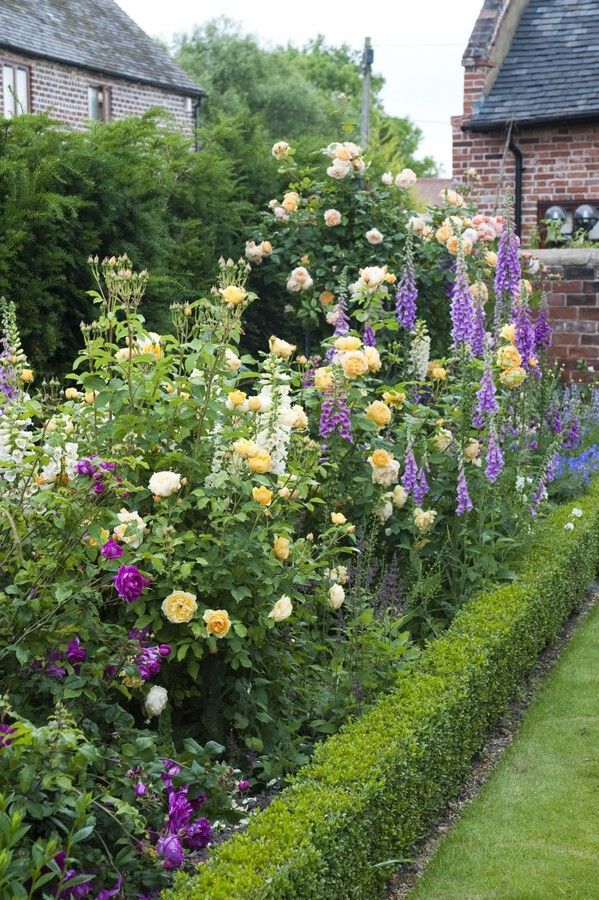 Modern gardening practice tends to favor designing a rose garden so that roses sit amongst perennials, biennials, and annuals, however – both because it looks more contemporary and because it helps to prevent rose sickness. For example, salvias (such as the fabulous hot-pink ‘Cerro Potosí’) are thought to act as natural fungicide because their leaves contain sulphur.
Modern gardening practice tends to favor designing a rose garden so that roses sit amongst perennials, biennials, and annuals, however – both because it looks more contemporary and because it helps to prevent rose sickness. For example, salvias (such as the fabulous hot-pink ‘Cerro Potosí’) are thought to act as natural fungicide because their leaves contain sulphur.
1. Plant roses as hedging or en masse
(Image credit: Future / Justin Paget)
‘We like to bring the luxe look of roses into the gardens of modern homes,’ says Pennsylvania-based landscape designer Nathan Tuno , who works at Roots Landscape Inc .
‘Roses done as a hedge or a large mass grouping work beautifully in contemporary landscapes. Stick with neutral tones such as white or blush, or perhaps yellow to give a pop of color while staying cool and understated. We lean on the Knock Out rose varieties, such as Sunny Knock Out or White Knock Out. They produce an abundance of delicate flowers while being unfussy.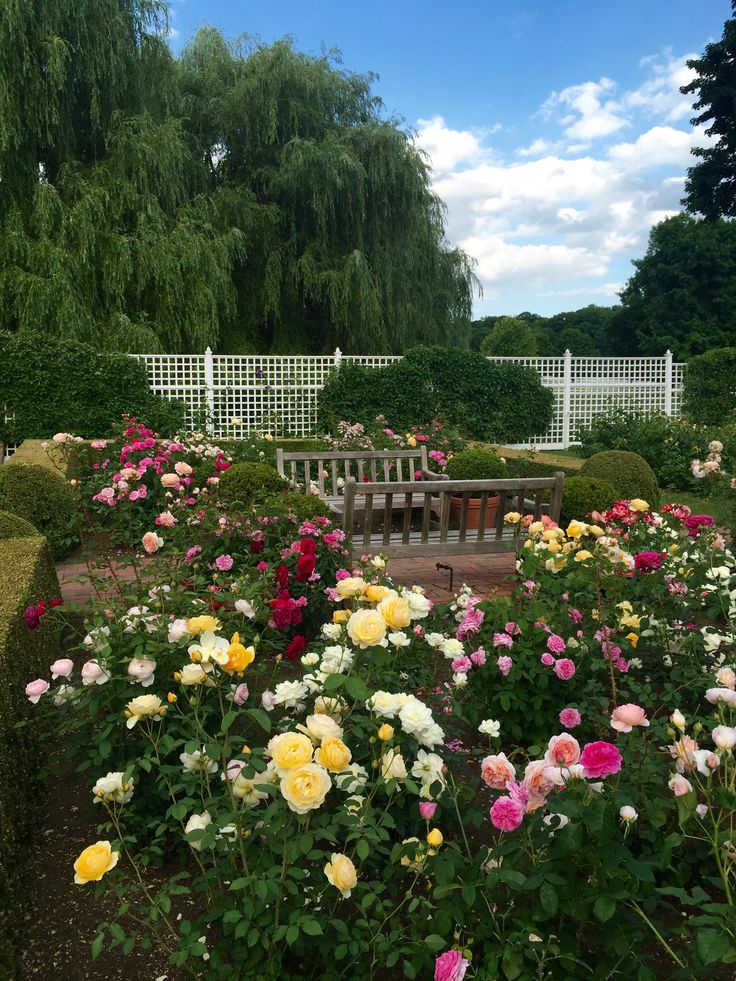 ’
’
2. Plant roses for a wildlife garden
(Image credit: Alamy)
Many garden designers like to use wild species roses (or single and semi-double roses that have the look of wild roses) to create a wonderfully informal, natural look, while providing food for wildlife.
‘I especially love the pasture rose (Rosa carolina),’ says Maryland-based landscape architect and designer Kirsten Coffen . ‘This rose is native to North America and grows especially well in coastal areas and sloping terrain. The bright-pink flowers are born in spring and throughout the summer and are a much loved food source for bees and other pollinators.’
Such wild roses are superb grown as a rose hedge or as part of a mixed native hedge – wonderful wildlife garden ideas.
3. Grow roses through a tree
(Image credit: Alamy)
Growing a rose through a tree makes for a romantic, beautiful feature in the garden during summer. Make sure you select the right tree and the right rose for a knock-out combination.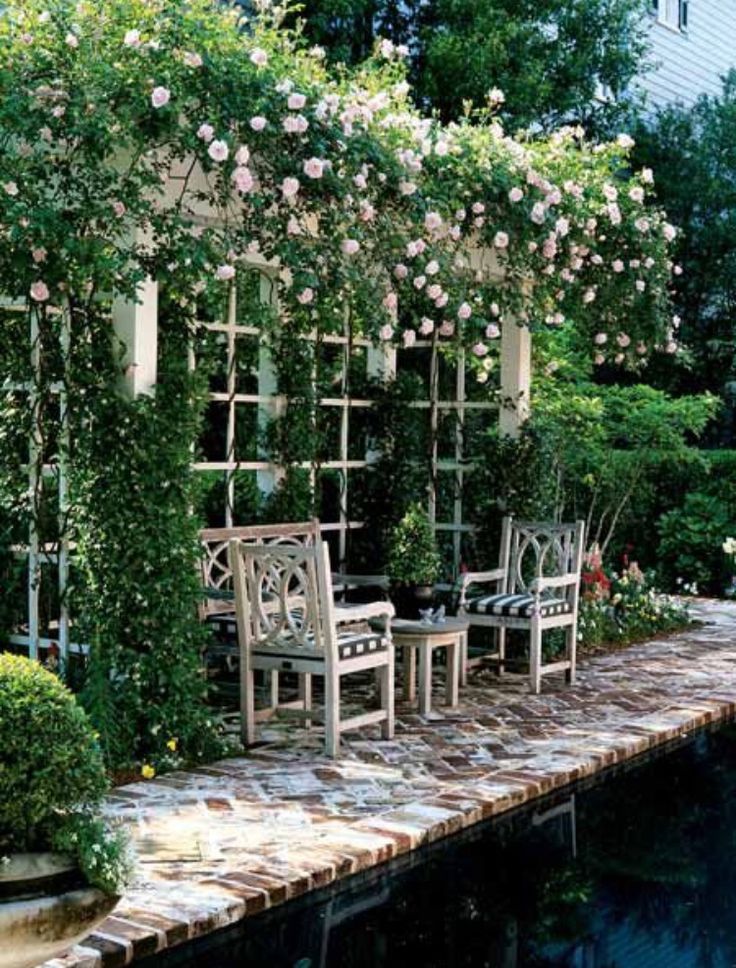
‘Choose a rambler that is not so vigorous that it will smother trees,’ advises Michael Marriott , one of the world's leading rose experts. ‘One of my favorite free-flowering ramblers is ‘Francis E. Lester’ , which has single soft-pink flowers like a wild rose, with a delicious musky fragrance. These are followed by similar quantities of small orange hips. It would be suitable for a medium-sized mature tree like an old apple. The advantage of growing into a tree is that once up there it needs no maintenance so all you have to do is admire it!’
4. Grow roses as ground cover
(Image credit: Alamy)
Procumbent roses sprawl over the ground, quickly suppressing weeds and concealing bare soil, and many of them have single or semi-double flowers that provide nectar for pollinators.
‘The Flower Carpet roses come in a variety of colors from dark red and bright pink to yellow and white,’ says Kirsten Coffen . ‘As ground cover, they combine beautifully with pale-blue catmints (Nepeta), which offset the hot flower colors.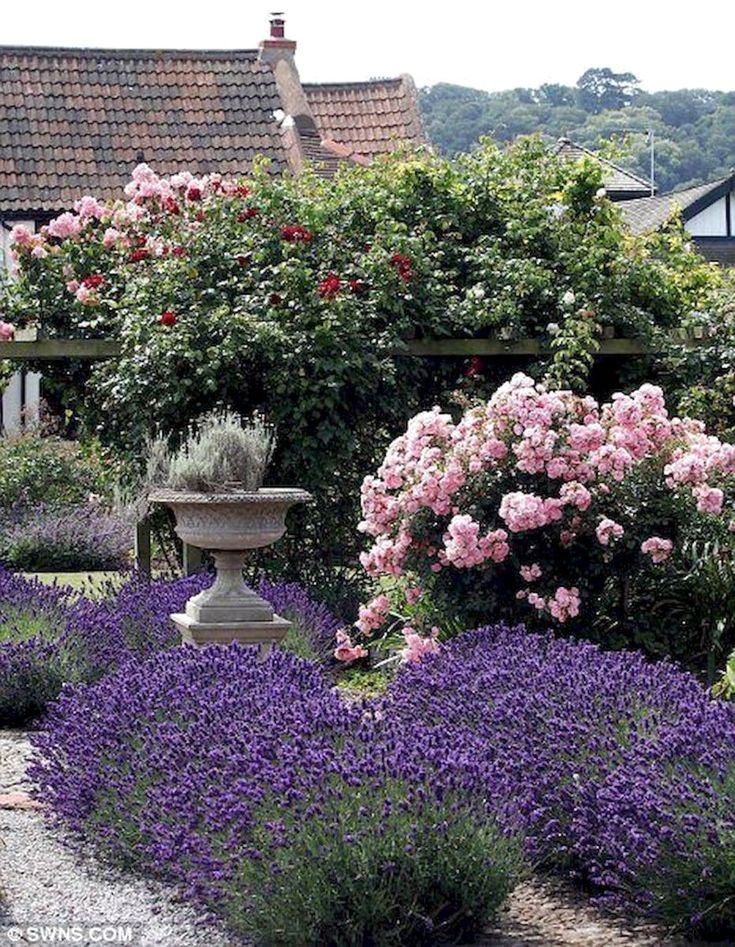 I like to use such roses to create a punch of color near a walkway or entrance space.’
I like to use such roses to create a punch of color near a walkway or entrance space.’
5. Grow a rose garden over a seating area
(Image credit: David Austin)
Repeat flowering and with beautiful fragrances, roses are a brilliant choice of flower for growing near a seating area. Try training a rambling rose, such as this Phyllis Bide variety by David Austin Roses , across an arch over a bench for a pretty garden retreat. A repeat flowerer with a medium, sweet scent and sprays of small, pale apricot-pink flowers, Phyllis Bide brings a romantic feel to the garden summer long.
(Image credit: RHS Rosemoor)
Take a more informal approach to growing roses and include them as part of a mixed border of shrubs and herbaceous perennials to bring color and height. Planting them alongside plants such as Achillea Mollis and Sea Holly will create a romantic cottage garden feel as these borders at The Cottage Garden at RHS Rosemoor prove.
7. Plant roses in color blocks for impact
(Image credit: RHS Rosemoor / Jason Ingram)
Planting multiple roses of the same variety is often seen in formal rose gardens and can look truly show-stopping. If doing this be sure to plant in odd numbers. If you're looking for inspiration, The Queen Mother’s Rose Garden at RHS Rosemoor has a fantastic array of modern rose types including Hybrid tea (large-flowered), floribunda (cluster-flowered) and shrub roses.
If doing this be sure to plant in odd numbers. If you're looking for inspiration, The Queen Mother’s Rose Garden at RHS Rosemoor has a fantastic array of modern rose types including Hybrid tea (large-flowered), floribunda (cluster-flowered) and shrub roses.
8. Line a path with rose arches
(Image credit: National Trust Images / Marianne Majerus)
Training climbing roses over pergolas and arches along an avenue or pathway can make moving through a garden truly magical, as this image from the walled rose garden at National Trust Mottisfont proves, featuring arches covered in Rose Adelaide d'Orleans. Other climbing roses perfect for growing up an arch include The Generous Gardener, Malvern Hills and Constance Spry – unrivalled for scent. If you’re looking for rose garden inspiration be sure to visit National Trust Mottisfont, home to the National Collection of pre-1900 old-fashioned roses.
9. Pair roses with lavender for a cottage garden feel
(Image credit: David Austin Roses)
Planting shrub roses with lavender is a classic combination which will guarantee a relaxed cottage feel and will bring color and fragrance throughout the summer.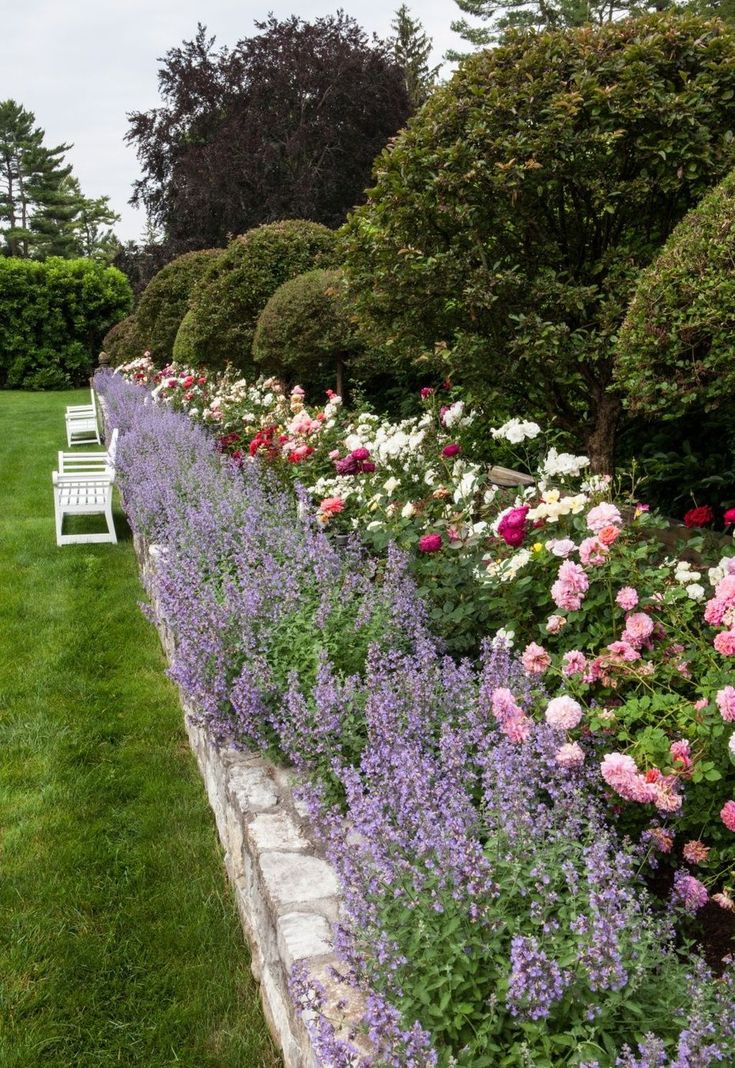 According to the rose experts at David Austin Roses , simple combinations cannot be underestimated; try planting its Boscobel rose with English lavender for a show-stopping and easy-to-maintain display.
According to the rose experts at David Austin Roses , simple combinations cannot be underestimated; try planting its Boscobel rose with English lavender for a show-stopping and easy-to-maintain display.
10. Use rambling roses to soften garden walls and structures
(Image credit: David Austin)
Climbing and rambling roses are a brilliant way to bring height and colour to a garden and are particularly useful if you’re looking to obscure unsightly structures. A classic rambler, David Austin’s Phyllis Bide, is a repeat flowerer that can grow up to 4.5 metres tall making it brilliant for this purpose.
- See: How to take rose cuttings – tips for propagating roses
11. Grow a rose garden around a doorway
(Image credit: Future / Britt Willoughby)
Growing a rose around a doorway can really make a feature of an entranceway. If growing a rose around a doorway, seating area, place where people pass or children play, then consider a variety with few thorns such as Mortimer Sackler or The Shepherdess.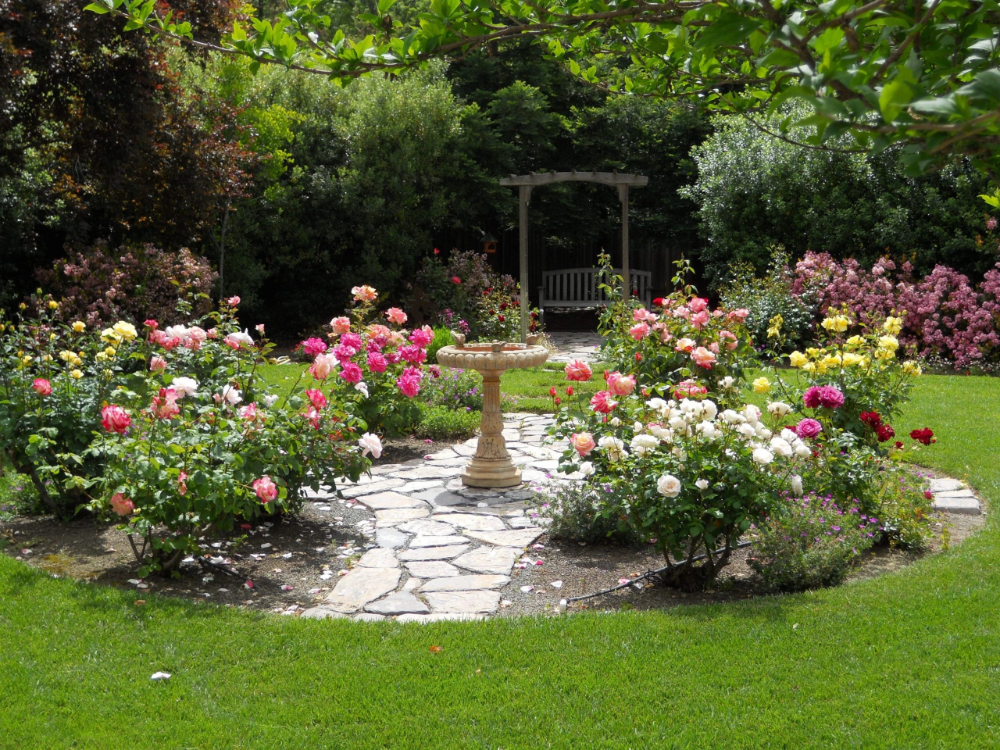
12. Brighten up patios with potted roses
(Image credit: David Austin Roses)
If space is at a premium then roses can easily be grown in containers to bring scent and color to a patio. Good roses for growing in pots include Harlow Carr, Princess Alexandra of Kent, Desdemona and Vanessa Bell, all available from David Austin Roses .
Raised garden bed ideas are another great way to incorporate roses into a more structured scheme.
13. Grow a rose over an obelisk to give height to borders
(Image credit: Leigh Clapp)
Growing a climbing rose up an obelisk is a brilliant way to bring height to mixed borders. Loved for its strong, Old Rose scent, Gertrude Jekyll is a brilliant choice for an obelisk which will bring beautiful fragrance and quintessential elegance to any garden.
14. Create a focal point with a rose-covered pergola
(Image credit: National Trust Images / Johnathan Buckley )
Growing a climbing or rambling rose over a perogla or gazebo can make a spectacular focal point in a garden.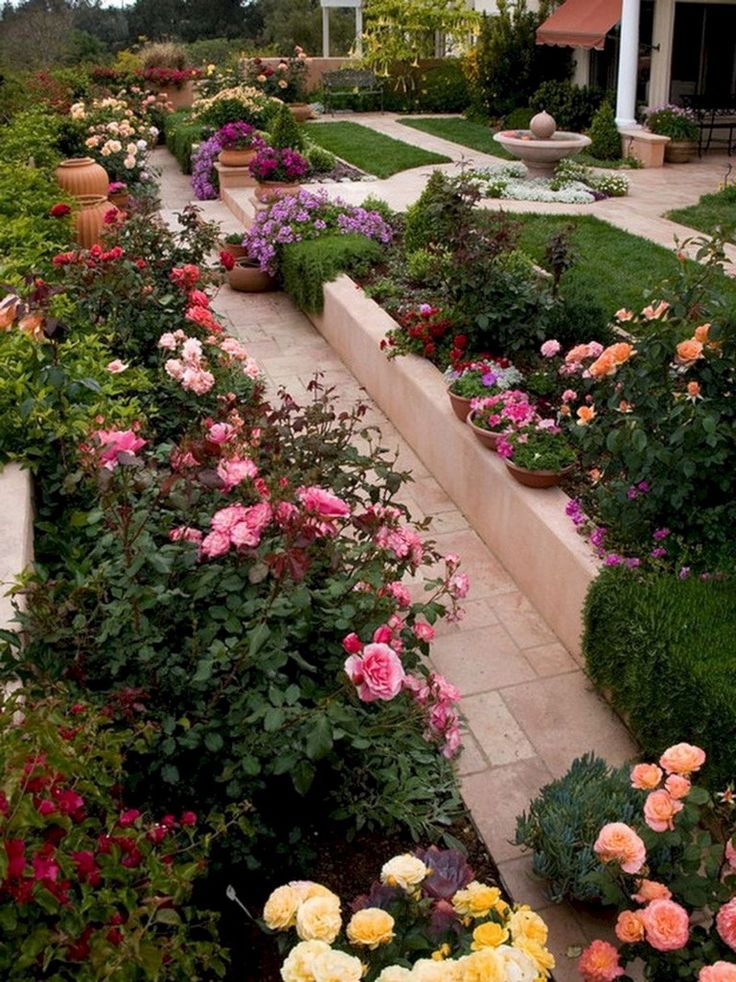 With their cascading, clusters of blooms and whimsical 'rambling' nature ramblers are a great choice for this, including varietes such as Rosa mulliganii, one of the biggest rose varieties, pictured here at Sissinghurst Castle Garden in the care of the National Trust.
With their cascading, clusters of blooms and whimsical 'rambling' nature ramblers are a great choice for this, including varietes such as Rosa mulliganii, one of the biggest rose varieties, pictured here at Sissinghurst Castle Garden in the care of the National Trust.
How do you start a rose garden?
Prepare your path
The best soil for planting roses should be free-draining, slightly acid and medium in texture – neither sandy nor clayey. If your soil type differs from this, you can improve it by digging in lots of organic material – a few minutes of extra effort at this stage can lead to a healthy plant that gives you years of pleasure.
Start them well
It’s not advisable to plant new bushes where other roses have grown in the last three years, as this will greatly increase the risk of ‘rose sickness'. This occurs when fungi that grew around the roots and soil of the old plant start to attack the new one. The addition of around 30g of mycorrhizal fungi per rose bush is particularly helpful in poorer soil conditions or when roses are planted in areas where roses have previously been grown.
Choose the right rose
Bush roses look great in island beds mixed with perennials, while miniature varieties make excellent edging plants in front of the taller varieties. Shrub roses on the other hand, planted singly, can make excellent specimen plants, and you can also try clustering shrub varieties to make a flowering hedge. Smaller roses can be grown in pots.
Care for your roses
Deadheading roses is an important part of caring for a rose garden; doing so regularly during flowering season will keep yours neat.
Which roses are best for wildlife?
Roses with single or semi-double flowers because their nectar and pollen are accessible to bees and hoverflies. The golden rule is: if you can’t see the yellow stamens, a rose is not wildlife-friendly.
Great examples include the charming blush-white Jacqueline du Pré and the cheering, striped rosa mundi ( R. gallica ‘Versicolor’ ), which work well in borders. Garden designers increasingly use such single and semi-double varieties to create a contemporary, naturalistic look.
‘For wildlife, I suggest Comte de Champagne with almost single, soft-creamy-yellow flowers of medium size,’ says Michael Marriott . ‘They have many golden-yellow stamens in the center making them very attractive to wildlife. If not deadheaded, they will set a lovely crop of hips.’
Other great shrub roses that provide hips to feed birds during fall include ‘Scabrosa’ , which has fruit that resembles cherry tomatoes, and ’Geranium’ , which is hung with incredible flagon-shaped scarlet hips in the fall. Many ramblers (such as ‘Francis E. Lester’ ) are also excellent for hips. But not all roses produce hips, so check with your supplier.
Pippa is Content Editor on Homes & Gardens online contributing to Period Living and Country Homes & Interiors print issues. A graduate of Art History and formerly Style Editor at Period Living, she is passionate about architecture, creating decorating content, interior styling and writing about craft and historic homes.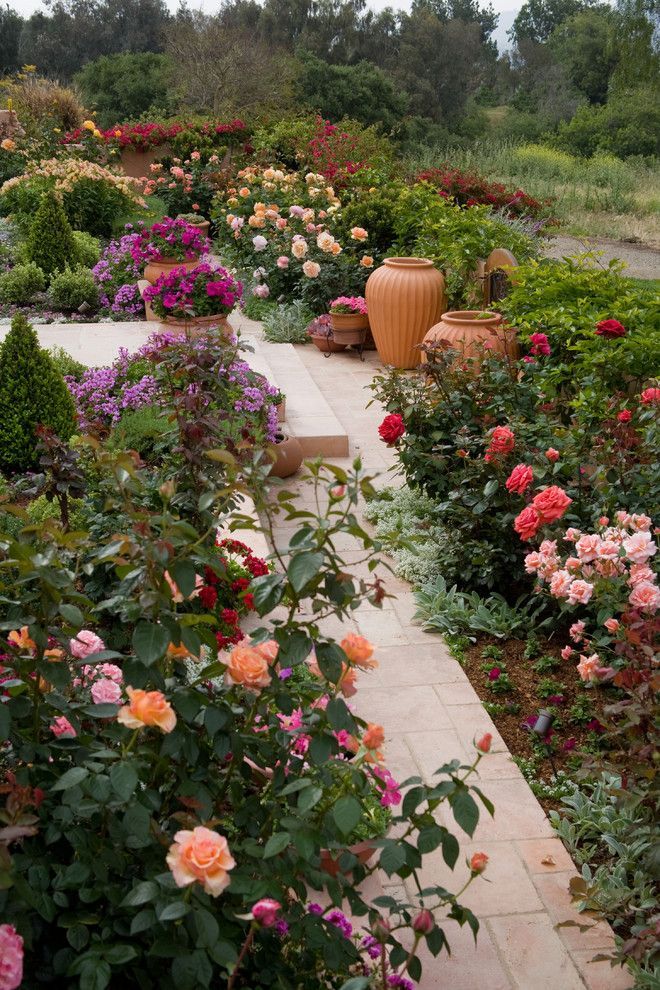 She enjoys searching out beautiful images and the latest trends to share with the Homes & Gardens audience. A keen gardener, when she’s not writing you’ll find her growing flowers on her village allotment for styling projects.
She enjoys searching out beautiful images and the latest trends to share with the Homes & Gardens audience. A keen gardener, when she’s not writing you’ll find her growing flowers on her village allotment for styling projects.
The color scheme of the garden - Landscape design
The material was provided by the NAYA Landscape Center
The magic of the garden lies not only in its beauty, but also in the variability of appearance, in the change of pictures, impressions and associations only on the weather, time of day or season, but also on the internal state of the observer. It is not surprising that on a clear sunny day the garden seems joyful, full of vitality. The combination of green foliage with bright colors of garden flowers, lush grass flooded with streams of sun on lawns can drive away sad thoughts and inspire the most optimistic hopes in a person. And, on the contrary, on a cloudy cold day, when the heavy sky hangs over the tops of the trees, reflected by a gray veil in the mirror of the pond, everything around becomes sad.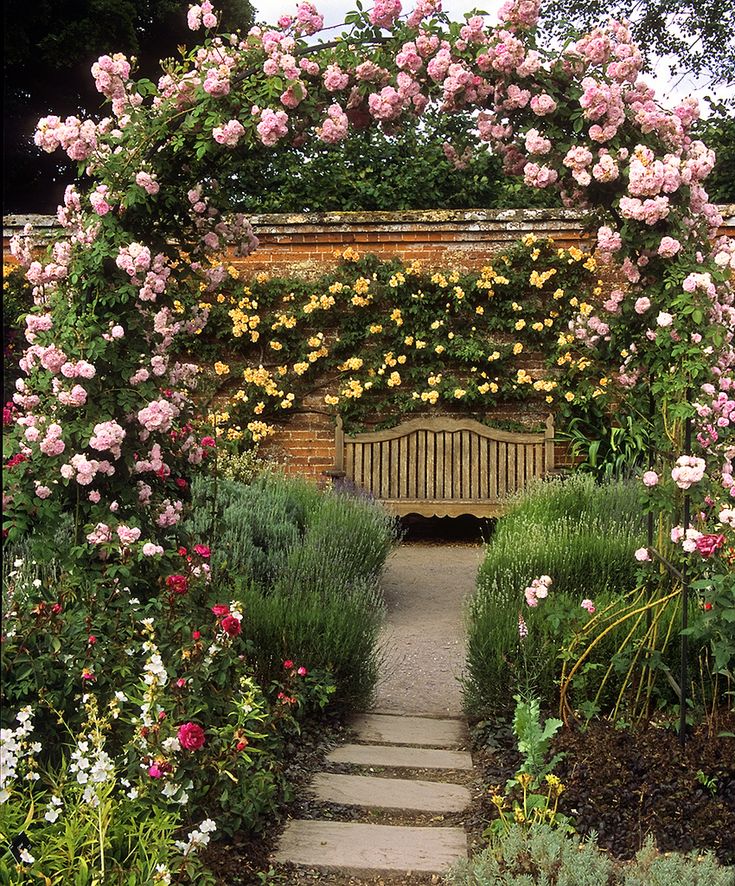
A garden dominated by yellow-orange colors will remind you of the sun and warmth even on the most cloudy day. Bright flowerbeds, mixborders, flowerbeds, made up of a combination of perennial and annual plants with flowers of various warm shades, ornamental trees and shrubs with variegated and golden foliage and needles - the main accents of "sunny" garden . In such a garden, a sundial arranged in an unusual way would be very appropriate. The numbers of such watches replace groups of yellow flowers planted in a circle. Varietal marigolds up to 20 cm high are best suited. Garden furniture made of light-colored natural wood well matches the general mood of the garden.
White Garden refined, a little restrained, a little sad. This is a memory garden. It calms and evokes melancholy. The combination of green and white, at first glance, may seem monotonous. But this is not so already because the range of plants is so extensive that in the color of their leaves and flowers you can find a wide variety of shades of white with an admixture of salad, pink, cream.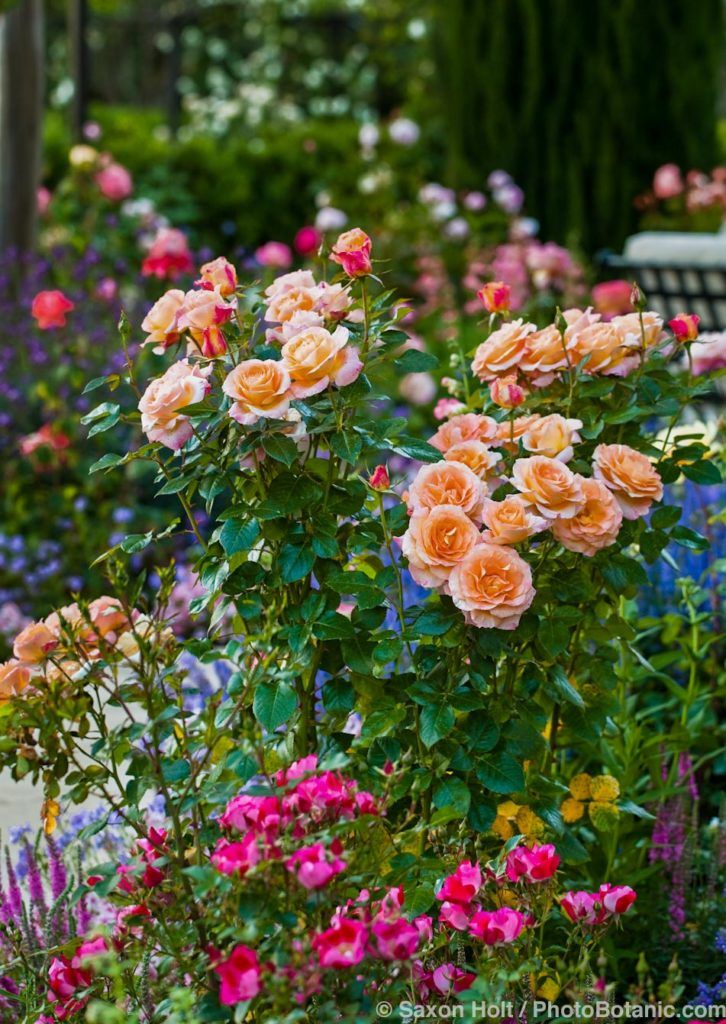
Blue garden is like a fairyland. A coldish mystery, some mystery and even detachment are the predominant motif of such a garden. Unfortunately, in central Russia there are practically no woody plants with flowers of pure blue or blue tones. Perhaps, only the flowering of certain varieties of lilacs, rhododendrons and not quite winter-hardy buddleia can be called lilac-violet, but not blue at all. Thus, the appearance of the blue garden is formed by flower beds, which must be thought out very carefully. An excess of blue-purple can create a gloomy impression. Therefore, it is desirable to "dilute" the cold scale with white or delicate pastel colors.
Rose garden has a completely different mood. The serenity of pink is close to children and lovers. In warm pink and raspberry tones, it is cozy and calmly at home. Perhaps the rose garden is not so refined, perhaps there is no mystery in it, but how much charming charm and tenderness! Such a garden creates an ideal environment for relaxing with the family, making you forget about the bustle of the city for a while.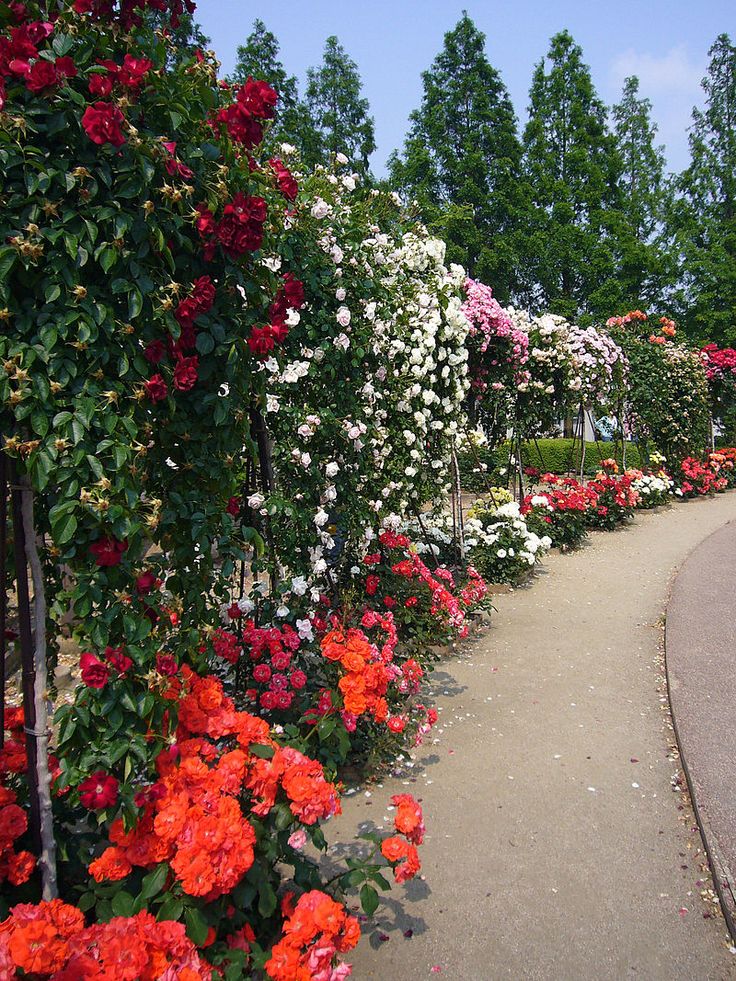
Melania Trump criticized for the new design of the White House Rose Garden
Komsomolskaya Pravda
WorldwideUS presidential election in 2020
Alena GRITSENKO
August 24, 2020 10:47
to give the Rose Garden the look it had in 1962Photo: GLOBAL LOOK PRESS
In July, the wife of US leader Donald Trump, Melania, decided to update the Rose Garden at the White House.
This part of the territory, adjacent to the residence of the American presidents, has its own importance: press conferences are held in the garden, foreign guests are received, and on Thanksgiving Day they arrange a pardoning ceremony for turkeys.
Talking to landscape designers, Melania said she would like to give the Rose Garden the look it had in 1962, when John F. Kennedy was President of the United States. It was also necessary to put in order the audio system. The designers took into account the requests of the first lady of the United States and in three weeks gave the garden a new, magnificent look.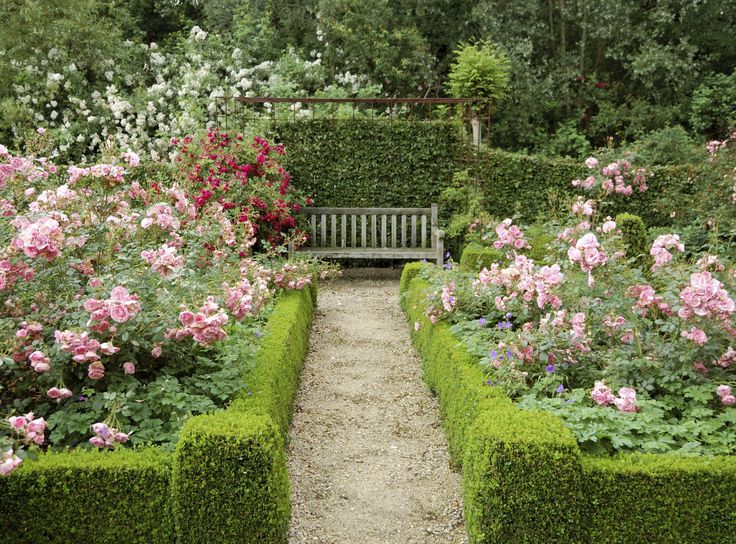
After the completion of the work, the First Lady tweeted that she would like to thank everyone involved in renovating the iconic and magnificent site. She also noted that she honors history and hopes that even more wonderful events will take place in the Rose Garden.
"We must preserve the history and beauty of the White House for our children and future generations," Melania Trump tweeted. “That is why we have recreated a garden that will live up to American ideals.
But not everyone shared her joy. Kurt Eichenwald, a former reporter for one of America's most influential newspapers, The New York Times, criticized Melania Trump. In social networks, he burst into an angry message, saying that he did not understand how a native of Slovenia, who received US citizenship only in 2006, can take on the holy of holies and destroy the history of the state.
Many NYT readers agreed with him, but Eichenwald did not receive strong support. On the contrary, he was accused of xenophobia.




